Rhetoric and expression in the mid-seventeenth-century French Air: a rationale for compositional style and performance1
Catherine Gordon-Seifert
- Introduction
- Despair or Hopelessness (le désespoir)
- Power, Courage, or Boldness (le pouvoir)
- The Burning Fires of Love
- Sorrow, Grief, or Pain (la douleur)
- Languor (la langueur)
- Tenderness, Sweetness
- Happiness (le contentement)
1. Introduction
Bénigne de Bacilly’s treatise, Remarques curieuses de l’art de bien chanter, first published in 1668, is typical of mid-to-late seventeenth-century French treatises on music in its application of rhetorical principles to performance. Here, he states that singing airs is analogous to declaiming a discourse – ‘one must know how to sing well and declaim well at the same time’2 – alluding only to the fifth part of rhetoric, actio.3 The emphasis in Bacilly’s treatise upon pronunciation underscores the dominance of performance over composition in the seventeenth-century musical experience in France; thus, as Bacilly insists, the rules that govern singing French-language airs must also apply to their composition.4 Strategies related to actio provided composers with a means of fulfilling vocal music’s primary aesthetic function, a function it shared with oration: moving the passions associated with a text and its recitation. Just how this was accomplished is articulated in treatises on rhetoric, not music.
Rhetoricians identify two ways in which passions are represented in recitation: through nombre or the rates of speech and accens or tones of voice. Nombre is specifically addressed by Bernard Lamy who was concerned with the physiological and psychological effects of various qualities of sound in his De l'art de parler, first published in 1675.5 Although Lamy considers only language in his treatise, his advice was easily applicable to another sound source: music. And indeed, in his L’Art de la poësie françoise et latine avec une idée de la musique from 1694, Pherotée de la Croix applied Lamy’s theories to musical sounds.6 Those sections of La Croix’s treatise that concern music were copied directly from Lamy’s treatise, differing only by adding the word music to Lamy’s statements. Both Lamy and La Croix stress the effects on the soul of the numerical proportions of speech called nombre. La Croix, copying directly from Lamy, writes: ‘one calls number, in the art of speaking and of singing, what the ears perceive as proportionate in the recitation of a discourse, either following the proportion of the measure of time, or according to the just distribution of the intervals of breath.’7 Both Lamy and La Croix assert that proportion in the pronunciation of discourse and music is linked to the passions. As La Coix points out: ‘It is a question of making the numbers conform to the things one expresses, in order to excite with success the movements (passions) that one wants.’8
Several rhetoricians also describe the tones of
voice, called accens, associated with
passionate recitation, defined by Marin Mersenne as ‘an inflection or
modification of the voice or of the word by which one expresses the passions or
affections naturally or by artifice.’9
Mersenne
notes that la musique accentuelle incorporates the accents used for
raising or lowering syllables (l’aigu and le grave or high and
low accents) and must be accompanied by a quickness or slowness of movement (nombre).10
Rhetoricians indicate, for example, that boldness or courage is characterized
by a voice that is lofty, forceful, and full of energy, while happiness is
portrayed by a voice that is easy, brisk, and flowing. Both rates of speech and tones of voice combine to express
passion, and both could be easily imitated through a variety of musical
devices: rates of speech primarily through the interplay of rhythm and metre
and tones of voice through melody and harmony.
In setting a poem to music as a type of persuasive
discourse, composers had to take into account the text, and, in the words of
Lamy, its accessory meaning or passionate associations.11
Poems used by mid-seventeenth-century composers are rich in words that invite
affective representation, the passions themselves being frequently indicated by
name. There is a consistent correlation throughout the repertory between a
passion named in a text and its musical setting. Additionally, if the passion
is not named but implied in the meaning of a phrase, similar expressions receive
similar musical treatment.12
In airs written during the 1650s and 1660s,
particularly by composers Michel Lambert, Bénigne de Bacilly, Sébastien Le
Camus, and Joseph Chabanceau de la Barre, seven passions dominate and are given
special musical treatment.13
The agitated passions, so identified by seventeenth-century rhetoricians, are
despair or hopelessness; boldness, particularly in commands or emphatic
statements; and the burning fires of love. The moderate passions are sorrow,
languor, and tender love; and the neutral passion, happiness. When considering
affective representation in music, it is important to realize that
seventeenth-century theorists, among them René Descartes and Mersenne,
considered certain musical devices to be strong and others, weak. Melodic and
bass line ascents were considered strong,14
while descents, weak;15
a high tessitura, strong; a low tessitura, weak; large verbal units, strong,
and small verbal units, weak. Chords in root position built on the first and
fifth notes of the mode were considered strong,16
while first inversion chords, weak17
;
large and expanded intervals (fifths, fourths, and tritones) were considered
strong,18
and narrow intervals, particularly minor seconds, weak. Major thirds and sixths
were considered strong, though not as strong as fourths and fifths,19
while minor thirds and sixths, weak.20
And finally, most dissonances were considered strong.
All of the passions named in song texts are defined and examined in seventeenth-century French treatises on rhetoric by Abbé de Bretteville, René Bary, Jean-Léonor Le Gallois, sieur de Grimarest, and Michel Le Faucheur, and by Descartes in his treatise on the passions from 1649.21 Brief descriptions of these passions are given below. The descriptions are accompanied by a list of musical devices generally used to represent each passion as well as musical examples from airs by Lambert and Bacilly.22 There is a remarkably close correlation between the descriptions of emotional states given in the treatises on rhetoric, Descartes’ physiological account of the passions, and the musical devices used by composers to imitate affects represented in the texts:
2. Despair or Hopelessness (le désespoir)
Descartes:
Despair is a violent kind of agitation. The spirits are sent rapidly from the brain to all parts of the body, particularly the heart, which sends more spirits back to the brain to maintain and strengthen the passion. Because more spirits rush to the brain than for any other passion, all the senses are more acute and all parts of the body more mobile. Despair results when the desired object is hopelessly unattainable.Bretteville:
Despair is a violent and impetuous movement by which the soul distances itself from something good that it cannot possess, after having searched for it with ardour.
Grimarest: Its Manifestation in Recitation
Despair is an exclamation and a tone of voice that is high, abrupt, exaggerated or outraged, and violent (un ton aigu, précipité, outré, violent).
The Musical Representation of Despair:
- The melody is in the highest register of the piece.
- The melody ascends primarily by step and always ends with an ascent, usually by a semitone.
- The rhythmic movement is primarily by large values in large verbal units, which gives emphasis to important strong syllables; often dotted rhythms or a semibreve followed by two crotchets are used.
- The bass line often moves in contrary motion with the melody; on stronger expressions, disjunct bass movement is likely.
- Tonic/dominant harmonic relationships are emphasized, especially at the end of the phrase.
- Chords are most likely to be in root position, rather than first or second inversion.
Figure 1: Lambert, ‘Inutiles pensers’: Les Airs, bb. 7–10, p. 8.

‘... and of my despair’
Figure 2: Lambert, ‘Que me sert-il’, Les Airs, bb. 17–20, p. 44.

‘... of a vain hope’
Figure 3: Lambert, ‘Inutiles pensers’, Les Airs, bb. 13–17, p. 8.

‘To take away my desire to see her’
3. Power, Courage, or Boldness (le pouvoir)
(strongly stated opinions, commands, demands, emphatic statements, or anger)
Descartes:
Courage is a ‘certain heat or agitation which disposes the soul to apply itself energetically to accomplish the tasks it wants to perform.’ Because it is a species of desire, the two passions share many of the same traits. The difference is that outrage disposes the soul to accomplish the task required to obtain the object of desire and depends upon hope for success in attaining the goal. Despair, on the other hand, results when the attainment of the desired object is impossible, leading to hopelessness and the eventual extinction of the desire altogether.
Bretteville:
Courage is ‘a passion of the soul, which strengthens it in the face of danger, and makes it attack the evil, in order to fight it and conquer it.’
Grimarest and Bary (l’audace): Its Manifestation in Recitation
L’Audace and despair are two of the most agitated passions; audacity should be represented by an impetuous or forceful and lofty voice (une voix impétueuse et hautaine).
Le Faucheur: Its Manifestation in Recitation
‘Confidence... will be easily discover’d by a Loud and a Strong Voyce, always keeping up to a Decent Boldness and a daring Constancy.’
The Musical Representation of Power, Courage, or Boldness:
- The melody is in the highest register of the piece.
- The melody often stresses chord tones of the tonic and dominant harmonies.
- The melody moves primarily in disjunct motion by fourths and fifths, though often there is a mixture of disjunct and conjunct motion.
- Single pitches are repeated for emphasis.
- Dotted rhythms are prevalent particularly at the end of phrases.
- Often two crotchets ascend to a note of a larger value.
- The bass line moves primarily by large note values in disjunct motion.
- Tonic/dominant harmonic relationships are emphasized whether in the key of the piece or not.
- The contour of the melody varies, though ascending motion dominates.
Figure 4: Bacilly, ‘Puisque Philis est infidelle’, Les Trois, bb. 4–9, p. 4.
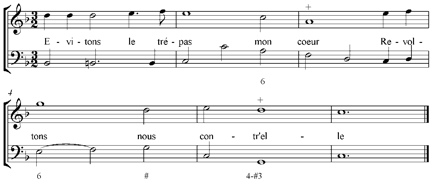
‘Let us avoid death my heart / Let us revolt against her’
4. The Burning Fires of Love
In song-texts, the burning fires of love are referred to in a variety of ways. Je brûle nuit et jour (I burn night and day), la flame (the fires of love), une maladie (a disease or illness associated with being in love, called erotic melancholia by doctors) are all used in reference to intense feelings of love and sexual desire.
Descartes:
Burning love is ‘the desire which arises from attraction.... Attraction ... is specifically ordained by nature to represent the enjoyment of that which attracts us as the greatest of all the goods belonging to mankind, and so to make us have a burning desire for this enjoyment.’
No description given by Bretteville, Grimarest, Bary, or Le Faucheur
The Musical Representation of Burning Love:
- The melody ascends chromatically, especially at the beginning of the phrase.
- The melody resolves with a descending motion, often by a semitone, at the end of the phrase.
- The melody usually appears in a low to middle register of the piece.
- Dotted rhythms dominate the phrase.
- The bass line remains relatively inactive at first and then descends by step at the end of the phrase.
- The harmonies move primarily by fifths.
- The contour of the melody primarily ascends; it then descends suddenly at the end of the phrase.
Figure 5: Lambert, ‘D'un feu secret’, Les Airs, bb. 1–5, p. 60.

‘I feel myself consumed by a secret fire’
5.
Sorrow, Grief, or Pain (la douleur)
Descartes:
Sorrow is associated with listlessness caused by a severe restriction of the openings of heart. The blood in the veins is not agitated at all, so that very little blood goes to the heart, which causes the limbs to relax and remain motionless. Tears result from a moderate feeling of sadness when accompanied by some feeling of love or joy. Descartes claimed that sadness must be combined with these other emotions so that the ‘quantity of vapours’ is sufficient enough to form tears; extreme sadness causes too great a constriction of blood throughout the body and not enough vapors for weeping.
Bretteville:
Although Bretteville did not describe the physiological aspects of sadness, he associated this passion with a languishing and fearful voice (une voix languissante, craintive) which is interrupted by sighs and groans.
Grimarest: Its Manifestation in Recitation
This passion is accompanied by a weak, lingering, and plaintive voice (une voix foible, trainante, plaintive).
Le Faucheur: Its Manifestation in Recitation
‘He’ll discover his Grief... with a dull, languishing and Sad Moan; not without breaking off abruptly sometimes, with a sob; and fetching-up a sigh or a groan from the heart.’
Musical Representation of Sorrow
- The melody is characterized by descending conjunct motion and emphasizes the minor second.
- The melody or melodic phrase often encompasses an interval of a minor third.
- The melody is almost always in the middle, sometimes low, register.
- Phrases end typically with an interval of a descending minor second.
- The bass line moves by leap or by semitone, depending on the force of the expression.
- Minor harmonies dominate the phrase.
- The cadence at the end of the phrase is often subdominant to tonic (or at least forms a relationship of a fourth between the harmonies).
- The melody always descends.
Figure 6: Lambert, ‘Inutiles pensers’, Les Airs, bb. 6–7, p. 8.

‘Children of my sorrow’
6. Languor (la langueur)
Languor is a species of sadness and is closely related to la douleur, as the representation of fatigue and inertia is common to both passions. But there is a difference in the way composers set one or the other affect. On languorous expressions, indecision that often accompanies this passion is represented with a wavering melody that vacillates up and down, ending up where it began, and phrases that begin and end with the same harmony. Weakness associated with fatigue is projected through melody, bass line, and harmonies that stress the interval of a third (usually the minor third) and, in particular, by rhythms that simulate ‘gasps for breath’ within small verbal units. The melody often descends by minor seconds and remains in the middle register of the piece.
The Musical Representation of Languor:
- The melody line often ascends a bit and then immediately descends and ends up just about where it began.
- The interval of a third (usually minor) is stressed either by a leap of a third or by a conjunct melody that outlines the third.
- The melody often descends by minor seconds.
- The melody is almost always placed in the middle register of the piece.
- The rhythms are either two crotchets followed by a semibreve, in a descending passage, or steady crotchets leading to a semibreve.
- The bass line either moves in conjunct motion by thirds, or it leaps by thirds.
- The harmonies often relate by thirds (from D minor to F major, for example).
- Often the phrase begins and ends with the same harmony.
- The contour of the melody resembles a wave.
Figure 7: Lambert, ‘Que me sert-il’, Les Airs, bb. 5–8, p. 44.

‘To languish night and day for her’
7. Tenderness, Sweetness
Tenderness often regards facial expressions or pleasantness, in particular sweet or tender eyes. This sentiment often appears in the adjective form doux and is associated with expressions of tender or sweet love. Tenderness is a mild form of sexual desire in contrast to burning love and is often accompanied by the musical representation of sighs.
Descartes:
‘Tender love presupposes sadness, so we are moved to sigh when ‘some imagined hope or joy opens the orifice of the venous artery which sadness had constricted.’
Bretteville: Its Manifestation in Recitation
Tender love is expressed by a sweet and agreeable voice (une voix douce, agréable).
Grimarest: Its Manifestation in Recitation
Tender love is associated with a flattering and tender voice (une voix flateuse, tendre).
Le Faucheur: Its Manifestation in Recitation
‘He will shew his Love best by a soft, a Gay, and charming Voyce.’
Musical Representation of Tenderness:
- The melody moves in conjunct motion by minor and major thirds, or it outlines triads.
- The melody appears in the middle register of the piece.
- Major and minor harmonies alternate and are closely related to the tonic.
- The bass moves by seconds and thirds.
- First inversion chords dominate.
- Rhythmic patterns are repeated throughout the phrase.
- The melodic contour resembles an arch.
Figure 8: Lambert, ‘O Dieux comment se peut il faire’, Les Airs, bb. 5–7, p. 12.

‘That under a face so sweet’
8. Happiness (le contentement)
Descartes:
Joy is a pleasant emotion associated with a regular pulse which is faster than usual.
Bary: Its Manifestation in Recitation
Le contentement is associated with a full and flowing voice (une voix pleine, coulante).
Grimarest: Its Manifestation in Recitation
Happiness is associated with a sweet (tender), full and easy tone (un ton doux, plein, facile).
Le Faucheur: Its Manifestation in Recitation
‘He’ll discover his Joy well with a Full, flowing and Brisk Voyce’
Musical Representation of Happiness:
- Expressions of happiness are always in major mode.
- The melody either moves in disjunct motion by fourths and fifths combined with conjunct diatonic motion, or it moves in simple conjunct motion in melody and bass.
- Often melodic patterns are repeated throughout the phrase.
- A homophonic texture is suggested by the same rhythmic movement in melody and bass.
- The harmonies are closely related to the tonic, major, and emphasize the tonic/dominant.
- Regular rhythms fall into repeated patterns.
- Duple metre is used in light songs, while triple metre is used for expressions of happiness in bitter-sweet airs.
- Phrases are of an equal number of syllables set to an equal number of bars.
- The contour of the melody resembles an arch.
Figure 9: Bacilly, ‘On est heureux’, Les Trois, bb. 1–3, p. 66.

‘On is happy to love nothing’
A comparison of despair and sorrow shows the degree to which musical representations of different passions can differ. Despair is described as a violent kind of agitation which results when the desired object is hopelessly unattainable. In recitation, despair is expressed by a tone of voice that is high, abrupt, exaggerated or outraged, and violent. In Lambert’s Inutiles pensers on ‘and of my despair’, given above, Lambert used what would have been considered the strongest of musical devices. These same devices were also used in setting ‘a vain hope’ from Que me sert-il and ‘to take away my desire to see her’ from Inutiles pensers, both texts referring to the hopelessness associated with despair. The settings show a melody that ascends to the highest register of the piece, decisive and accented rhythmic movements organized into large verbal units, an emphasis on strong tonic/dominant harmonic relationships, and root position harmonies. By contrast, sorrow is represented in a very different manner than despair. Lambert set ‘children of my sorrow’ from Inutiles pensers with weak musical devices: a melody that descends, is broken up into three small verbal units ‘Enfans – de ma – douleur’, concludes with a descending semitone, and is accompanied primarily by minor harmonies.
Passionate representation is not prescriptive but flexible, governed by a number of factors which correspond to several of René Descartes’ assertions about the passions from his Les passions de l’âme. Noteworthy is the correlation with his three-step emotive process. According to Descartes, a stimulus or object causes some kind of passionate response, which in turn causes the body to react.23 And indeed, in all song texts there is reference to an object, usually the beloved, affective responses, such as despair, sorrow, and boldness, and an action, such as a declaration of love. Song texts always reveal the types of passionate responses and subsequent action(s) in response to the object and these determine whether an air was considered serious, light, or hybrid.24 Serious airs are characterized by rhythmic patterns and melodic contours mimetic of natural speech, which often warranted metre changes and irregular phrasing.25 The more agitated passions and sorrow are most often represented in serious airs. Light airs are typically chansons à danser, vaudevilles, and airs de mouvement and are characterized by measured rhythms, symmetrical phrases, and tuneful melodies.26 Light airs are dominated by expressions of tender love and the neutral passion, happiness. Hybrid airs were referred to as chansonnettes, petits airs, or petits airs sérieux later in the century. Many of these are the more stately dance types, particularly the sarabande and gavotte, and are usually less measured and tuneful than dance airs and popular songs.27 Hybrid airs include primarily representations of sorrow, languor, and tender love.
The composers’ settings of song texts reflect three
other assertions made by Descartes:
- more than one passion is often aroused by the object
- passions are felt with greater or lesser intensity
- passions often mix together to form new
passions.28
All of these assertions regarding the passions are exemplified in Lambert’s setting of the serious air ‘Mon ame faisons un effort.’29 Here, the speaker declares his love for Silvie, knowing that he will be rejected and thus ‘die.’ In this example, Lambert varied the accens and nombre from phrase to phrase, and within phrases as well, to invoke the variety of passions suggested by the text.30 By so doing, Lambert underscored the man’s loss of emotional control by representing different emotional states in succession in order to imitate an impassioned speaker whose discourse, according to rhetoricians, was to be interrupted by the diverse movement of the passions, unequal, and devoid of a regular cadence.
Two passions dominate Lambert’s setting: boldness, associated with the speaker’s declaration of love, and sorrow, associated with the loss of the beloved and his impending death.
| Line of Poetry |
Affect |
|---|---|
| 1. My soul let us make an effort: |
Sorrow and Boldness
|
| 2. Since I burn I must complain: |
Burning Love and Boldness |
| 3. Let us speak there is no longer time to pretend: |
Boldness (Sorrow) |
| 4. We are too close to death |
Despair |
| 5. Do not be offended Silvie |
Boldness and Tenderness (sorrow) |
| 6. If I lose respect I also lose my life |
Sorrow and Boldness (with suggestions of despair, burning love, and tenderness) |
Both boldness and sorrow are represented in lines one, three, five and six. Lambert also represented the burning fires of love in line two and despair in line four; not only are the passions in these two lines suggested by the text, but their musical representations contrast with the surrounding phrases to better imitate the diverse movement of the passions.
Lambert’s means of combining musical features associated with different passions constitute the most significant feature of his setting. The musical representation of line one, Figure 10, seems an expression of sorrow, with its melodic descent of a fifth to the final of the mode. Yet a closer examination reveals that Lambert mixed strong musical devices, associated with boldness and the speaker’s effort to declare his love, and weak devices, associated with the sorrow at the loss of the beloved and prospect of his death.
Figure 10: ‘Mon ame faisons un effort’, bb. 1–4.

Lambert divided this line into two verbal units, three syllables in the first and five in the second, clearly delineating the two units in b. 2 by the return to an F major harmony, the large note value on ‘-me’ of ‘ame’, and by the placement of the rest before ‘faisons’. Lambert set the first unit, ‘mon ame’ with one of the most common devices associated with sorrow: a melodic descent of a minor third, a sort of extended sighing figure. Here, Lambert accompanied the sigh with the harmonic progression I-V-I in F, associated with strong passions, but he appropriately softened the utterance by the placement of the dominant chord (C major) in first inversion and by the semitone movement in the bass (F to E). The small verbal unit and the use of the two equal semibreve note values in the melody on ‘a-’ and ‘-me’ would warrant a slow and equal recitation.
Lambert changed the affect in the second verbal
unit of five syllables. ‘Faisons’ is a command and is treated as such, yet it
is slightly weakened by its placement in a low register and by the use of the
second inversion F chord under ‘-sons’, but the weakening of the command is
only secondary, as strong musical devices dominate the phrase. Though boldness
dominates this large verbal unit, Lambert altered the affect again, weakening
the expression suddenly with the deceptive motion at the end of the phrase. We
expect a strong cadence leading to an F major harmony, but the harmony moves
instead to D minor.
The D minor harmony prepares the listener for the important allusion to the lament affect in b. 4, the descending minor tetrachord in the bass just before ‘Puisque’, Figure 11, used here to foreshadow the textual references to death. Minor mode, triple metre (in this bar, three semibreves), and ambiguity of phrase length were all common features of the lament.31
Figure 11: ‘Mon ame faisons un effort’, bb. 4–6.
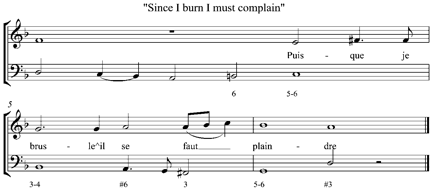
This second phrase begins with a declaration of burning love and ends with a statement of necessity. The misplaced bar line in b. 4 not only suggests lament, but also serves as an important guide to proper declamation. Here, by placing the bar line before ‘brusle’, Lambert saved the greatest stress for this most important word of the phrase. Typical of impassioned statements of lust, the intensity of recitation builds to the climax of the phrase on ‘faut’ and then suddenly falls off on ‘plaindre’.
Lambert interpreted the third line, Figure 12, with bold tones (‘Let us speak it is no longer time to pretend’). Even though line three is a strong utterance, it resembles the first line of the piece in its descending melodic shape, thereby suggesting sorrow as well as boldness. But Lambert raised the pitch by a major second, so the melody extends from D to G, instead of C to F (a rhetorical figure known as gradation). He also used strong musical devices; the dissonant seventh chord accompanies the strong syllable ‘lons’ of ‘parlons’, the command; the bass ascends chromatically (F, F#, G) at the end of b. 7; and most chords are major sonorities in root position. But Lambert fooled us again on the cadence at the end of the phrase, appropriately to represent the word ‘feindre’ (‘pretend’). We expect a movement from D major to G minor, but, instead, Lambert moved to C minor in first inversion. Perhaps the two unexpected cadences in b. 4 and then again in b. 8, represent the speaker’s hesitation to act boldly, as a strong V-I cadence would presume a more decisive action.
Figure 12: ‘Mon ame faisons un effort’, bb. 6–8.

Metre change from duple to triple, as in b. 6, commonly occurs throughout this repertory, but in this example the change causes an ambiguity in the unit of beat. Should the performers move from a semibreve unit of beat to a minim, or should the semibreve beat equal a dotted semibreve, thereby fitting three minims into the unit of beat instead of two. Maintaining the established pulse of the semibreve in b. 6 but subdividing by three instead of two would certainly add to the feeling of urgency or agitation required by the text. But there is another ambiguity associated with this passage. Beginning in b. 7, on ‘-lons’ of ‘parlons’, there are six minims or two dotted semibreves in the bar, even though 3/2 is indicated in the previous bar. The best interpretation might be to treat this phrase as a free representation of speech declamation using the dotted semibreve as the unit of beat,32 which conforms to Bacilly’s definition of an air as ‘a song in free metre’ as distinct from dance airs.33
In any case, Lambert’s placement of the bar line guides the performer to stress ‘-lons’ of ‘parlons’, which should receive greater emphasis than the ‘plus’. Despite the semibreve value on ‘plus’, this word should, in fact, receive less stress than the word ‘temps’ which follows, even though ‘temps’ is set with a smaller note value.34 This large bar demonstrates a larger grouping of syllables within the verbal unit than is usually associated with this series of rhythms. The singer would need to maintain a forceful recitation throughout the bar by stressing to some degree all four long syllables: ‘-lons, ‘ ‘plus’, ‘temps’, and ‘fein-’ of ‘feindre’, strength of recitation being associated with boldness by rhetoricians.
Lambert interpreted line four, Figure 13, as an expression of despair (‘We are too close to death’). This agitated affect is invoked particularly by an ascending melody, dissonance, and a rhythmically active bass within one large verbal unit.35
Figure 13: ‘Mon ame faisons un effort’, bb. 8–10.
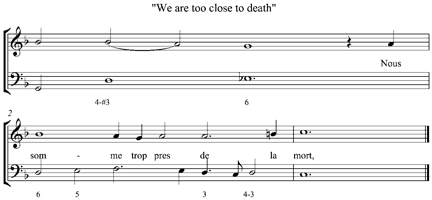
A command (‘Do not be offended Silvie’) begins the second half of the air, Figure 14:
Figure 14: ‘Mon ame faisons un effort’, bb. 11–14.

The repeated A’s in the melody and F’s in the bass and the ascent of a fourth in the melody are typically bold. But because the speaker is addressing his beloved, Lambert appropriately turned the command into an utterance of tender love, associated with the melodic descent by major and minor thirds outlined by steps, the alternation of major and minor harmonies (F major to D minor, Bb major to G minor, and Eb major to C minor to D major), and by the return to a measured recitation in triple metre (3/2).
Lambert mixed the greatest number of passions on line six, Figure 15. The phrase begins sorrowfully on the words ‘Si je pers’, but the sequential treatment given the repetition of the text at a higher pitch level intensifies the affect (a rhetorical figure, in this case, known as synonymia).36
Figure 15: ‘Mon ame faisons un effort’, bb. 15–18.

‘Le respect’, at the end of the phrase, continues the strong affect, resembling the desperate statement regarding death. Lambert not only invoked despair on the word ‘respect’, he also symbolizes death by the return of the descending tetrachord in the bass (D to A to accompany ‘le respect’, bb. 17 to 18). Losing respect in this repertory refers to a declaration of love, yet by doing so, the speaker ‘dies’.
Lambert continued to represent death in the last phrase (‘I also lose my life’), Figure 16, in association with his declaration of love, inflected with both bold and sorrowful tones:
Figure 16: ‘Mon ame faisons un effort’, bb. 18–20.

It is at this point in the air that Lambert’s simulation of dying by the melodic descent of a fifth, from the C, beginning the repetition of ‘Si je pers’, to the final note, F, and its connection to the declaration of love are made explicit, serving to unite almost every phrase of the first strophe with this idea:
Line one: He asks his soul to make an effort [to speak out].
Line two: Since he burns, he must complain [speak out]
Line three: He must speak out, there is no longer time to pretend [because he is too close to death].
Line five: He asks his beloved not to be offended because he must speak out.
Line six: He is going to speak out
(lose respect); thus, he will die.
‘Mon ame faisons un effort’ is a serious air and so consists of two strophes or verses of text. Because lyric poetry was considered a type of rhetorical discourse, song texts were subject to the emphasis that rhetoricians placed upon the organization of materials in an oration. Of the seven parts of the discourse most commonly identified by rhetoricians, most poems set by composers include up to six types of statements. As indicated below, the first strophe of the piece corresponds to the introduction, narration and proposition, while the second strophe or double makes up the confirmation, refutation, and conclusion.
First Strophe
| 1. Introduction |
My soul, let us make an effort Since I burn I must complain |
(Introduces what is to be 'proven') |
| 2. Narration |
Let us speak there is no longer time to pretend We are too close to death |
(Sets forth 'facts') |
| 3. Proposition |
Do not be offended Silvie If I lose respect, I also lose my life |
(States the issues related to what is to be 'proven') |
Second Strophe
| 1. Confirmation |
During my last day permit me To show you my martyrdom |
(Elaborates upon the primary topic) |
| 2. Refutation |
And at least I dare to say That in dying I die of love |
(Refutes opposing arguments) |
| 3. Conclusion |
Do not be offended Silvie If I lose respect, I also lose my life |
(Summarizes what was proven) |
A comparison of the first line, first strophe, of Lambert’s ‘Mon ame’ with that of the second, Examples 8 A and B, shows that Lambert reversed the order of expression on ‘During my last day permit me’, second strophe.
Figure 17a: ‘Mon ame faisons un effort’, First Strophe, bb. 1–4.

Figure 17b: ‘Mon ame faisons un effort’, Second Strophe, b. 1.

Instead of the inflection of sorrow on ‘My soul’, first strophe, Lambert set ‘Permit me’, the command, with bold tones through the repetition of the C’s, the insertion of a short bar, b. 3 (two halves per bar instead of two semibreves as in the first strophe), and the agitated flourish on ‘-tez’ of ‘permettez’. The line then concludes with sorrow, rather than boldness, in reference to his ‘last days’, achieved primarily by the addition of ornaments that imitate an extended sigh.
Line two of the confirmation, Figure 18b, ‘To show you my martyrdom’, is not an utterance of burning love as in the first strophe, Figure 18a, so Lambert altered the affect to project the forceful request for a declaration of love.
Figure 18a: ‘Mon ame faisons un effort’, First Strophe, bb. 4–6.
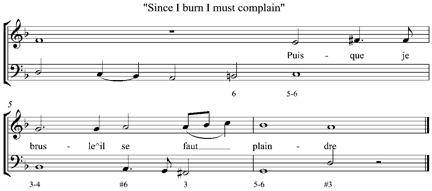
Figure 18b: ‘Mon ame faisons un effort’, Second Strophe, bb. 6–10.
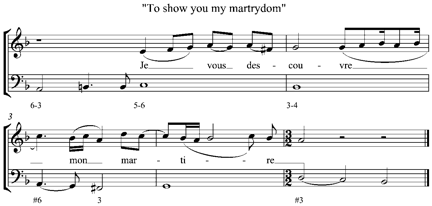
Note also that he changed the placement of the bar line to coincide with the stress on the strongest syllable of the most important word, ‘-cou-’ of ‘decouvre’. In this way, he maintained a duple metre throughout (alternating between 2/2 and 4/2), rather than inserting a bar of 6/2 at this point as he did in the first strophe.
The refutation, which rebuts any possible objections made by the beloved, Figure 19a, breaks up the bar to include three minims, rather than six, to accommodate syllable stress. As in the corresponding section of the first strophe, this portion of the air expresses primarily boldness followed by despair but does so with greater force through melodic flourishes, strong repetitions, and dissonance.
Figure 19a: ‘Mon ame faisons un effort’, First Strophe, bb. 6–10.
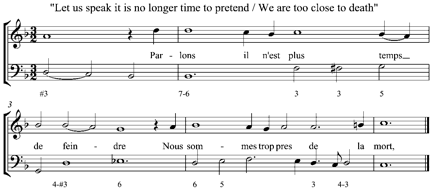
Figure 19b: ‘Mon ame faisons un effort’, Second Strophe, bb. 10–15.
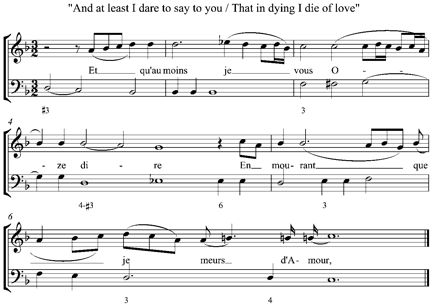
The last two lines of the second strophe comprise the conclusion which should not only recapitulate the topic of the song but also, in the words of Lamy, ‘awaken the motions [or passions] that we have excited.’ In ‘Mon ame faisons un effort’, even though the conclusion is a textual repetition of the proposition, Lambert intensified the expression through the types of ornamentation he added to the original melody, Figure 20b.
Figure 20a: ‘Mon ame faisons un effort’, First Strophe, bb. 11–20.
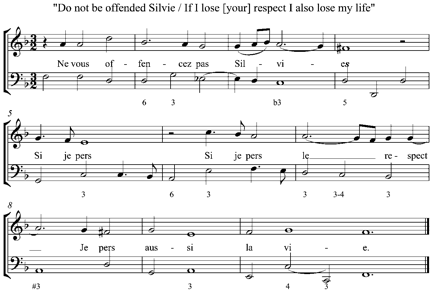
Figure 20b: ‘Mon ame faisons un effort’, Second Strophe, bb. 16–24.
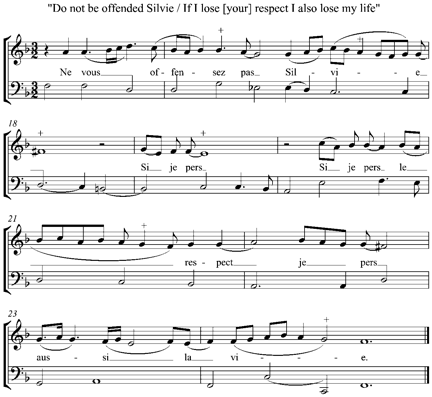
Here, the sorrowful and tender affects of the first strophe are made more pitiful, particularly through a multitude of sighing figures on words like ‘pas’, b. 17, on the last syllable of ‘Silvie’, bb. 17–18, on the three presentations of ‘pers’, bb. 19, 20, and 22, and even in the bass line in b. 18. By emphasizing a more pathetic version of the passions expressed in the first strophe, the conclusion successfully recapitulates with greater force and appeals to the listeners to have sympathy for one who, by declaring his feelings, becomes a martyr to love.
***
As this analysis of Lambert’s ‘Mon ame faisons un effort’ shows, despite the aesthetic imperative that music be mistress to its text, musical settings composed by the most skilful composers surpass the quality and meaning of the song texts. Lyric poetry from this period was highly conventional and, on the surface, not very interesting. In his novel Le Roman bourgeois, Antoine Furetière observed with disgust that lyrical poetry is ‘rubbish’. But when set to music by master composers, and sung by ‘the most beautiful mouths’, these texts become highly esteemed.39 Thus, music enhanced the worth and emotional appeal of even the crudest of poems. Furetière’s contention demonstrates music’s capacity to signify meaning beyond the text and underscores the importance of music as a sensual language with its own set of conventional symbols: its own rhetoric. But unless the airs are sung by someone who understands how to interpret textual and musical conventions and thus properly communicate passion through appropriate tones of voice and rates of speech, the music, too, becomes rubbish. The claim that a well-composed air must also be sung by a master performer, so ardently argued by Furetière, Bacilly, Mersenne, and others, is just as applicable today as it was in mid-seventeenth-century France.
Catherine Gordon-Seifert
Catherine Gordon-Seifert is a professor of music, Chairperson of the Music Department at Providence College , a musicologist, and a professional harpsichordist. She studied harpsichord with Edward Parmentier at the University of Michigan, Gustav Leonhardt in the Netherlands , and Peter Sykes in Boston and continues to perform as a soloist and with ensembles The Elective Affinities and a.m.p. baroque. She earned an undergraduate degree in music education and harpsichord performance from Bowling State University, a Masters degree in harpsichord performance from Indiana University, and a Masters and Ph.D. in musicology from the University of Michigan. Professor Gordon-Seifert is an active scholar and has participated in several musicological organizations in leadership positions on the international, national, and regional levels. Most recently, she has served as national secretary for the Society for Seventeenth-Century Music (SSCM) and as AMS-New England Chapter Representative. She also served as past president of the AMS-NE. She has presented papers on many occasions at the national conference of the American Musicological Society, the Society for Seventeenth-Century Music, the Historical Keyboard Society, the International Conference on Baroque Music, the International Musicological Society Conference, a special conference devoted to the music of Sébastien de Brossard sponsored by the Centre de Musique Baroque de Versailles in France, and Eros and Euterpe, a conference on music and eroticism sponsored by Indiana University. She has received a variety of research grants, including a National Endowment for the Humanities Grant, a French government research fellowship from the Centre National de la Recherche Scientifique, and a grant from the Providence College Aid to Faculty Research. In 2006, she was awarded the American Musicological Society’s Noah Greenberg Award, along with Elisabeth Belgrano and Stephen Stubbs, to make a CD of airs by Bénigne de Bacilly.
Her primary field of scholarship focuses on late seventeenth-century French airs or "courtly" love songs. Her book, Music and the Language of Love: Seventeenth-Century French Airs, recently published by Indiana University Press, explores rhetoric as the basis of conventional expressions of emotional states in French airs, published during the 1660s, and is an interdisciplinary work that incorporates the fields of rhetoric, poetics, aesthetics, social and cultural history, the science and physiology of ‘the passions of the soul’, music theory, and performance practices.
- The following essay is based on several chapters from my book on rhetoric and French airs: Catherine Gordon-Seifert, Music and the Language of Love: Seventeenth-Century French Airs (Bloomington, IN: Indiana University Press, 2010).
- ‘Sçavoir bien Chanter & bien Declamer tout à la fois’ (Bénigne de Bacilly, Remarques curieuses sur l’art de bien chanter et particulierement pour ce qui regarde le chant français par le sieur B.D.B. [Paris: Robert Ballard, 1668], 62–63; Bénigne de Bacilly, A Commentary upon the Art of Proper Singing (1668), trans. Austin Caswell [New York: Institute of Mediaeval Music, Ltd., 1968, 30]).
- All translations are my own unless otherwise indicated. The one consistent exception is passages from Bacilly’s treatise on singing translated by Austin Caswell. For the original French texts, I have maintained all original French spellings.
- Bacilly, Remarques curieuses, 331; Bacilly, A Commentary, 176.
- Bernard Lamy, L’Art de parler, avec un Discours dans lequel on donne une idée de l'art de persuader. Troisième edition. Reveuë & amp; augmentée (Paris: André Pralard, 1678). See also Lamy, The Art of Speaking... Rendered into English (London: W. Godbid, 1676), V.3.2; John Harwood, The Rhetorics of Thomas Hobbs and Bernard Lamy (Carbondale, Ill: Southern Illinois University Press, 1986).
- Phérotée de la Croix, L’Art de la poësie françoise et latine avec une idée de la musique sous une nouvelle méthode (Lyon: Thomas Amaulry, 1694. Reprint. Geneva: Slatkine, 1973).
- ‘On apelle nombre, dans l’Art de parler et de chanter, tout ce que les oreilles aperçoient de proportionné dans la prononciation du discourse, soit suivant la proportion des mesures du tems, soit selon une juste distribution des intervalles de la respiration’ (La Croix, L’Art de la poësie françoise, 652).
- ‘Qu’il s’agit de rendre les nombres conformes aux choses qu’on exprime, pour exciter avec succés les mouvement que l’on veut, & c’est le moiens de reüssir dans toutes les parties de la Musique, & dans L’Art de plaire & persuader’ (La Croix, L’Art de poësie, 658).
- ‘L’Accent... est une inflexion ou modification de la voix, ou de la parole, par laquelle l’on exprime les passions & les affections naturellement, ou par artifice’ (Mersenne, ‘L’Art de Bien Chanter’, Harmonie universelle, Contenant la Théorie et la Pratique de la Musique, 3 vols. [Paris: Sebastian Cramoisy, 1635–36; reprint, Paris: Editions du Centre national de la recherche scientifique, 1963], 366).
- Mersenne, ‘L’Art de Bien Chanter’, 366–76.
- Lamy, The Art of Speaking, 364.
- In French music from this period, the musical expression of an entire phrase was more important than that of an individual word. Bacilly writes: ‘there are others who maintain that an air is not well related to its text if it doesn’t express the sense of each particular word and who also contend that there are certain notes in music which are precisely effective for the expression of certain ideas such as sharpened notes and the use of flats for tender and passionate expressions. Naturally, these persons never hesitate to accuse a composer of dreadful ignorance if he should fail to use one of these particular devices on such words as ‘languor, torment, sadness, pity, suffering, dying, sighing , weeping, moaning, cruel....’’ (‘Il en est d’autres qui croyent qu’un Chant est mal appliqué aux Paroles, s’il n’exprime le sens de chaque mot en particulier, & mesme qui pretendent qu’il y a des marques de Musique qui sont précisement affectée pour la signification, & pour l’expression, comme sont le Dioese, & qu’ils ne hesitent point à traiter d’ignorant un Compositeur qui aura manqué à mettre une de ces marques sur les mots de ‘langueur, martyre, tristesse, tourment, pitié, souffrir, mourir, soupirer, pleurer, gemir....’’ [Bacilly, Remarques curieuses, 121–2; Bacilly, A Commentary, 54]).
- Lambert, Bacilly, Le Camus, and La Barre were not only considered the best composers of French airs during this period, they were also the only composers to publish collections of their own airs composed between 1650 or so and 1670. For a more detailed analysis of expressive representation in mid-century serious airs written by these four composers, see Gordon-Seifert, Music and the Language of Love, Chapters 3–5.
- The designation of strong and weak to various musical devices and the French approach to music composition is discussed at length in D. P. Walker, ‘Joan Albert Ban and Mersenne’s Musical Competition of 1640’, Music and Letters, 57 (1976), 233–55. As Walker points out in his article, melody ascension was generally considered to be appropriate to energy and protest (Walker, ‘Joan Albert Ban’, 248).
- In their assessment of Boesset’s ‘Me veux-tu voir mourir’, the judges agreed that falling intervals are appropriate for weakness and expressions of sorrow (Walker, ‘The Musical Competition’, 248).
- Seventeenth-century music theorists acknowledged the strength of chords built on the first and fifth notes of the mode (the tonic and dominant), especially those chords in root position (Benito Rivera, ‘The Seventeenth-Century Theory of Triadic Generation and Invertibility and its Application in Contemporaneous Rules of Composition’, Music Theory Spectrum, 6 (1984), 63–78).
- Seventeenth-century theorists stated that first inversion chords are weaker than root position chords. Henrius Baryphonus, in his Pleiades musicae (1630), noted that ‘when the third or fifth of the triad usurps the place of the basis, the sonority turns languid’ (quoted and translated in Rivera, ‘The Seventeenth-Century Theory of Triadic Generation’, 63–78).
- The interval of a fourth was considered to be harsh. Descartes observed that the fourth ‘is the unhappiest of all consonances’ (René Descartes, Compendium of Music, trans. Walter Robert [Neuhausen-Stuttgart: American Institute of Musicology, 1961], 24).
- Mersenne noted that ‘the force and effects of the modes. . .depends particularly upon their major and minor thirds and sixths’ (‘la force et les effets des modes. . .dépendent particulièrement de leurs tierces et sextes majeures et mineures’ [quoted in André Pirro, Descartes et la musique (Paris: Librairie Fischbacher, 1907; reprint Geneva : Minkoff, 1973]). According to Descartes, minor modes were considered less forceful and appropriate for sad affects, while the major modes were considered more forceful and appropriate for either joyful and vehement or agitated affects (Pirro, Descartes et la musique, 95 and 115 and Walker, ‘The Musical Competition’, 240–49). Mersenne also observed that minor thirds can be used to ‘soften’ harsh affects’ (Pirro, Descartes et la musique, 119). Other theorists perceived a difference between the major and minor third, major being strong and minor being weak. Keppler, for example, described minor thirds as ‘feminine and mournful’ and major thirds as ‘viril and vehement’ (quoted in Pirro, Descartes et la musique, 95).
- Descartes noted that major thirds and sixths are more agreeable and ‘gay’ than minor thirds or sixths (Descartes, Compendium of Music, 27).
- The following descriptions of the passions are taken from René Bary, Methode pour bien prononcer un Discours (Paris: Denys Thierry, 1679); René Bary, La Rhetorique françoise ou pour principale augmentation l’on trouve les secrets de nostre langue, rev. edn (Paris: P. Le Petit, 1673); Dominique Bretteville, L’Eloquence de la Chaire (Paris: Denys Thierry, 1689); René Descartes, The Passions of the Soul (1649), vol. 1 of The Philosophical Writings of Descartes, trans. and ed. Robert Soothoff (Cambridge: Cambridge University Press, 1985); and Jean-Léonor sieur de Grimarest Le Gallois, Traité du récitatif (Paris: Jacques Le Fevre et Pierre Ribou, 1707).
- All musical examples are either from Bénigne de Bacilly, Les Trois livres d’airs regravez de nouveau en deux volumes (Paris: [Richer], 1668) or Michel Lambert, Les Airs de Monsieur Lambert. . .corrigez de nouveau de plusieurs fautes de gravure, 3rd edn (Paris: Richer, 1666; facs. edn, Geneva: Minkoff Reprints, 1983).
- Descartes, The Passions of the Soul, 343–47. Charles Le Brun, who was influenced by Descartes’ theories of the passions, also incorporated the three-step emotive process (object-passion-action) into his explanation of ‘expression’ (Charles Le Brun, A Method to Learn to Design the Passions, trans. John Williams [London: F. Huggonson, 1734; reprint, Los Angeles: University of California, 1980], preface). Pierre Perrin also alluded to the appearance of the three in his consideration of modes, passions, objects, and actions (Louis Auld, The Lyric Art of Pierre Perrin. Founder of French Opera, 3 vols. [Ottawa: Institute of Mediaeval Music, LTD., 1986] 2:25).
- Pierre Perrin, in Recueil de paroles de musique (1667), used the terms grave and léger to distinguish between types of chansons (Théodore Gérold, L’Art du chant en France au XVII siècle [Strasbourg: Librairie Istra, 1921], 154). Perrin explained in his Recueil that he wanted to advance the art of composing airs by introducing some pieces of music which are more lofty and more serious since the light pieces are sufficiently well represented’ (Louis Auld, The Lyric Art of Pierre Perrin, Founder of French Opera, 3 vols. [Ottawa: Institute of Mediaeval Music, Ltd., 1986], 2:24). In his consideration of salon poetry written 1640 and 1660 (he refers to this poetry as les genres lyriques mondains), Alain Génetiot distinguishes between serious and light poetry (poésies sérieuses and legères) without citing its use in seventeenth-century theoretical sources (Alain Génetiot, Les genres lyriques mondains: 1630–1660: etude des poesies de Voiture, Vion d’Alibray, Sarasin et Scarron (Geneva: Libraire Droz, 1990], 16, 85–110).
- According to Pierre Perrin: ‘The Air proceeds in a free and grave measure and movement, and thus it is suited to express sincere, honest love, and the tender emotions which it evokes in the heart, emotions of sorrow or joy’ (quoted and translated in Auld, The Lyric Art, 2:29).
- In his Recueil, Perrin claimed that ‘the chanson differs from the Air in that the Air uses... a free measure and the Chanson a fixed measure—dance or other—either entirely or in some of its parts’ and explained that ‘the serious ones [chansons] are Sarabandes, serious Gavottes, and Courantes, and call for tender and grave texts, similar to those for Airs: and the Chansonettes, based on light-hearted dances, such as light Gavottes, Minuets, Gigues, Passepieds, Bourées, Canaris, Gaillardes, light ballet airs, etc, are better suited to playful or rustic words’ (quoted and translated in Auld, The Lyric Art, 2:30).
- Auld, The Lyric Art, 2:30.
- Descartes implied these three assertions in the following statements: 1) a husband who mourns the loss of his wife may feel sadness, but also may feel ‘remnants of love or of pity... [and] at the same time a secret joy’ (this is what Descartes called an internal passion as distinct from those passions ‘which always depend on some movement of the spirits’), 2) only extreme joy may cause fainting, or only a mild feeling of sadness when mixed with love can produce tears, and 3) regret is a kind of sadness ‘joined... to the memory of a pleasure that gave us joy’ (Descartes, The Passions, 381, 371, 374, and 402). See also Le Brun, A Method, preface.
- Lambert, Les airs, 4.
- Descartes, Grimarest, and Bretteville described objects that evoke more than one passion at a time. Descartes points out that sexual desire, for example, is pleasurable, yet it can be painful as well (Descartes, The Passions, 360). The sight of the beloved and feelings of desire are agreeable, yet the anticipation of future events produces an anxiousness (will the ‘love’ be returned?). If one is rejected, thoughts, visions, or memories of the beloved may still be pleasurable, yet the rejection causes great pain.
- This device was commonly used in seventeenth- and eighteenth-century music for laments and to symbolize death (Rosand, ‘The Descending Tetrachord: An Emblem of Lament’, Musical Quarterly, 65 (1979), 346–59.
- This passage resembles recitative with the anapest rhythm commonly used by Lully in his operatic recitatives. See Lois Rosow, ‘French Baroque Recitative as an Expression of Tragic Declamation’, Early Music, 11 (1983), 468–79.
- Bacilly, Remarques curieuses, 108; Bacilly, A Commentary, 49.
- Bacilly addresses issues of syllabic stress in his treatise on singing, explaining that both ‘plus’ and ‘temps’ are long syllables because they end in ‘s’, but ‘temps’ is the longer of the two according to Rule II, Part II, Chapter 3, ‘Method for Recognition of Long Monosyllables’ which states that words ending in ‘n’ or ‘m’ followed by another consonant are always the longest syllables without exception (Bacilly, Remarques curieuses, 356–67; Bacilly, A Commentary, 188–92).
- The restricted melodic range and the division of the line into small units, however, are commonly associated with references to death, even in desperate expressions. There are several examples of desperate utterances wherein the melodic range was restricted within a series of small verbal units in reference to death.
- German theorists made the analogy between repetition as a rhetorical figure and melodic repetition as a kind of musical figure. Mauritius Vogt referred to the repetition of a melodic idea in a different register (or in different parts) as polyptoton; Johann Gottfried Walther called the repetition of a melodic idea on different notes in the same part synonymia (George Buelow, ‘Rhetoric and Music’, The New Grove Dictionary of Music and Musicians, ed. Stanley Sadie (London: Macmillan Publishers, 1980), vol. 15, 793–803.
- Mersenne, ‘Embellissement des chants’, Harmonie universelle, 372; Duncan, ‘Persuading the Affections’, 156.
- As Bacilly notes: ‘They contend that ornamentation removes all the expression from vocal music, but that instruments are obliged to use ornamentation since they have no power of speech. I would say this to them: whatever expressivity is taken away from vocal music by diminutions is more than restored to it by the same practice as long as it is well done.... Diminution adds to the expression of a song, especially when the first and second verses are equally strong in their poetic statement.’ (‘Ils pretendent que cela oste toute l’Expression du Chant, & que dans les Instrumens on est obligé de s’en servir parce qu’ils ne parlent point. Mais on leur dit que tant s’en faut que l’Expression soit aneantie par les Passages du Chant, elle est mesme augmentée, pourveu que les Paroles soient également fortes dans un premier & second Couplet’ [Bacilly, Remarques, 213; Bacilly, A Commentary, 106]).
- Antoine Furetière, Le Roman bourgeois, ed. Jacques Prévot (Paris: Editions Gallimard, 1981), 108–9.